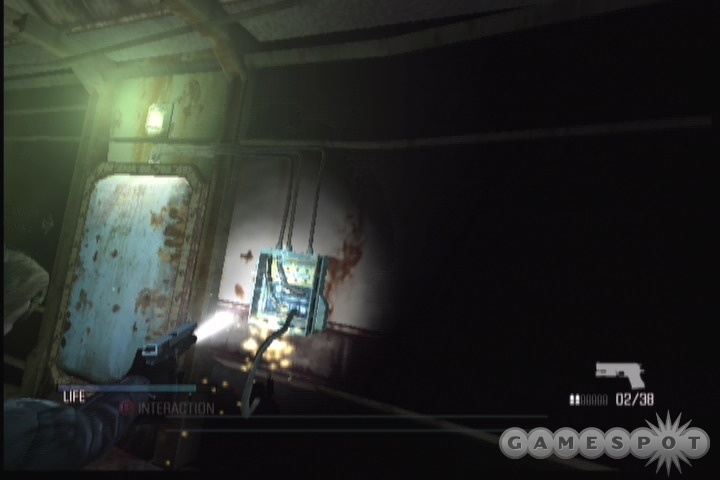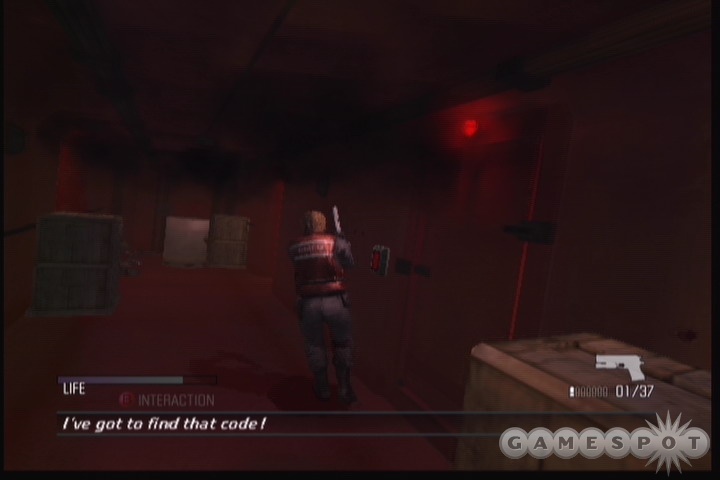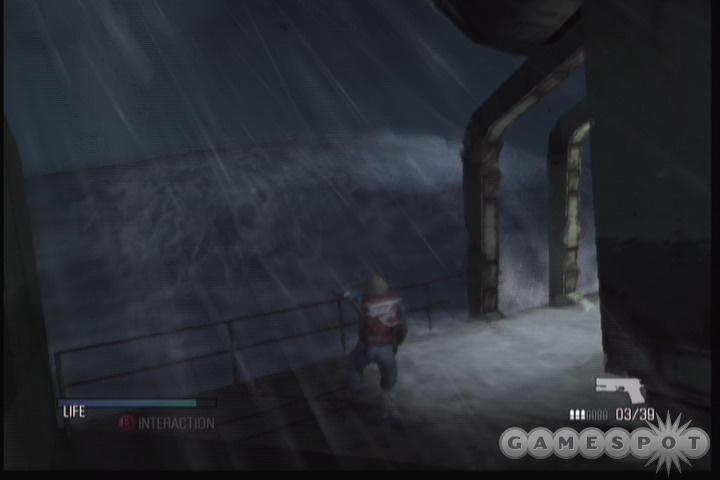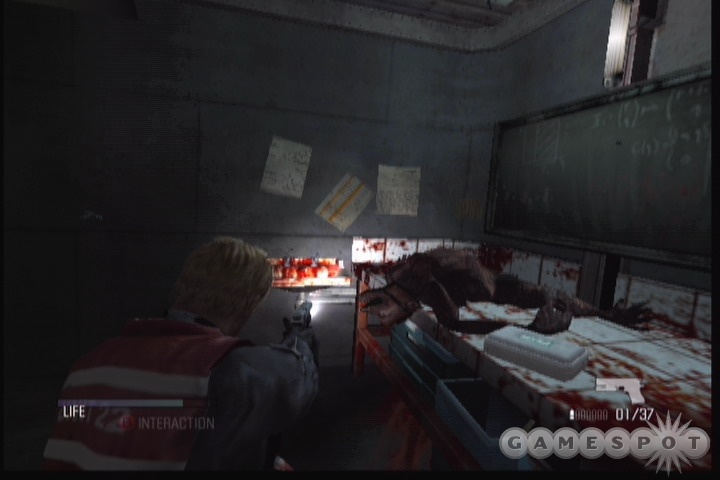Atmospherically, Cold Fear is derivative and predictable, which is a shame considering that it is, at times, an enjoyable action game. While Cold Fear does not exactly establish itself as a high-quality survival horror game, the involved story and occasional interesting gameplay element make Cold Fear worth playing, for at least a little while, anyway.

In Cold Fear, you play as Tom Hansen, a US Coast Guard officer who has been sent to investigate a mysterious Russian frigate on a windy and stormy night in the middle of the ocean. You find out early on that the boat is occupied not merely by hostile Russian soldiers, of which there are plenty, but also by alien creatures that feed on the humans and provide a severe threat from both inside and outside their host bodies. Your investigation leads you to a few friendly faces and many threatening ones as you uncover the mystery of the ship and its lethal cargo.
The perspective is third person, with the ability to go into a first-person aiming mode through which you can freely guide your view. Although the fixed camera gives a wider glimpse of the scene, it's not easy to keep fluid control when going back and forth between cameras, which is a problem as you try to maneuver around the boat and take out the enemies you encounter along the way. Additional controls let you crouch, run, and scroll quickly through weapons, which is slightly more intuitive in the PS2 version, thanks to the extra trigger buttons. However, since the weapon scroll is placed on the white/black buttons on the Xbox controller, the difference is not that severe. Running brings up an onscreen meter that, when depleted, prohibits you from running anymore. This helps to make certain puzzles more challenging, and you will find yourself monitoring the meter frequently, but it does not detract from or add to the gameplay in any significant way.
Because Cold Fear takes place in ocean-locked environments, the control scheme is affected by the movement of the waves. This is mostly noticeable when you are outside, and at times it looks like you're walking almost completely sideways, due to the volatile movement of the deck beneath you. This adversely impacts the controls, but the trade-off is a unique and interesting component of the gameplay. As you fight against the tossing of the boat, timing yourself to cross decks only when the waves are low, you encounter some of the most compelling aspects of Cold Fear. Unfortunately, the outside environments are not tapped to their fullest, and you'll spend the majority of the game, past the first hour, in generic indoor locations.
Your objective in Cold Fear is to discover the story behind the vessel's apparent destruction and the emergence of the nonhuman creatures upon it. Despite being a highly derivative story about a genetic experiment gone wrong, the relationship between characters is interesting, and the story is neat and simple. Most of the plot exploration is conveyed through notes that are littered about the environment and through dialogues with characters (for the short duration that the people on the boat other than Hansen manage to stay alive). The notes are well implemented, and they drive the story and reveal critical information about weapons, environmental objects, and enemies.
Although you start off with merely a handgun, there are a number of different weapons to be found in the middle of the ocean, including a submachine gun, an AK-47, a speargun, a flamethrower, and a grenade launcher. The weapons are almost all equally effective, except for differences in power. The speargun is the only weapon that is not used explicitly for dealing damage, and when fired, it releases a gas that draws enemies near it. This is a great tactic to use in conjunction with one of the more explosive weapons such as the shotgun or grenade launcher. Otherwise, the objective of the game is to make headshots on all humanoid enemies, which can be exceedingly difficult as the enemies draw nearer to you. Fortunately, most of the weapons have either a laser sight or flashlight, which aids your precision. The point of the headshot is to conserve ammunition, although enemies will not die unless they are decapitated. This means that if you shoot an enemy anywhere other than in the head, and merely knock it down to the ground, you have a certain amount of time to run over and step on the head before the enemy gets back up and attacks you again.
Many of the zombies are possessed by exocel creatures, which are spidery beings that alternate between crawling on the floor and the ceiling before attempting to take possession of a human being by reaching out a long tendril into a human's mouth and then climbing inside. Outside of a host body, these exocels are fairly easy to destroy--usually one bullet sends them rolling up into a ball, and a second one takes them out--but given their flexibility and their penchant for appearing out of nowhere, including bodies you've just killed, they provide a formidable threat if not dealt with quickly. More advanced abominations of genetics appear later on, but with the more difficult enemies, it's sometimes easier to merely avoid confrontation and run along to the next room. If you choose to run, you'll find these creatures often jumping on your back. When this happens, you're given a button sequence to throw the enemy and try to achieve a critical hit. If you successfully land a critical hit, enemies are killed much more quickly than if you had gone about it the normal way. Because of this, it's sometimes tactically important to let Hansen be jumped by enemies, as long as you can throw them quickly.

Other game tactics include using pieces of the environment to do the work for you. You can shoot explosive barrels, fire extinguishers, and different-colored valves to create an environmental trap for oncoming enemies. From time to time, you'll encounter a fight between two of the enemy species, and you can let them fight among themselves before you intervene. Environmental effects, such as laser beams and swinging obstacles, can often be used to pick off the less bright enemies, and the rocking of the boat will send a zombie or you overboard, if you're standing on the wrong side of a slippery surface.
That's all good, but a significant drawback to the gameplay is the lack of an in-game map. Hansen declares early on that he is able to remember some Russian, so he can translate the signs on and around the doors if you look at them with enough reverence--but because of the similarity of the areas and the sheer number of open paths at any given moment, you'll spend a great deal of time backtracking and trying to recall exactly which path to take. There are clues here and there, such as new enemies and changes to the environment, but for the most part you're left to wander the boat and figure it out on your own. And wander you will.

Saving is prompted automatically when you reach certain objective areas, which takes all of the control out of your hands. Usually the save points are close enough to each other that this isn't a problem, but it can be frustrating when you're unable to save on a whim and must wait until you happen upon the next point, which means you risk repeating a section over again. Likewise, inventory management is out of your control. Objective items that are used in the game's minimal puzzles, like security cards and door handles, are kept in the inventory and used automatically, but health packs cannot be stored--you'll use them instantly upon discovery, even if you have only a tiny sliver of health missing. This makes health management a more difficult task, but again, the game is generally forgiving, and health tends to appear when you need it the most.
Technically, the visuals in Cold Fear are good. The environmental effects in the outdoor portions are well done--the rain, wind, and waves reflect their ominousness, and the view is often obscured by splashing water droplets or blood from nearby enemies. This is much more apparent in the Xbox version, which looks and plays more smoothly than the PS2 version and also supports 720p. Most noticeably, the PS2 falters with some troublesome loading times, which, when coupled with frequent backtracking, lessens the experience quite a bit. Despite the graphical polish in both cutscenes and gameplay, Cold Fear does not capture the visceral visuals common to survival horror games. There is a decent amount of gore, but it is neither unique nor interesting. The graphics are attractive, but not deep.
The game's atmosphere takes a further hit because it is simply not that scary. Frights come in the form of canned surprise moments, which involve either a seemingly dead creature's resurgence or an enemy's appearance from behind an unexpected or unexplored corner. There is nothing compelling about either of these tactics, especially considering that at times the moment is merely for show, and the enemy will fall back down without providing the least bit of threat to Hansen. There are a few details in the game that are very imaginative, which makes it all that much more distressing that the backdrop for them is so unimaginative. From time to time, through the windows in the lightning, you'll notice a shadowy apparition for a brief moment, which is scarier than any of the gory scenes that you encounter. Enemies will also sometimes continue to attack you after decapitation, which provides for an interesting challenge, even if it is frustrating. Occasionally the enemy AI falters, and creatures will merely run off the boat or get stuck on portions of the environment. This is infrequent but very troublesome in a game for which atmosphere is so integral. Also particularly problematic is killing zombies on stairs, because you can't step over them and onto their heads to deal the fatal blow. This means that when confronted with enemies on the steps, you must either lead them onto flat ground or make sure you get a headshot.
The atmosphere's major saving grace is the music and sound effects. The music is dramatic and very flexible, changing with the mood as necessary. Although a couple of the tracks get repetitive and even slightly grating, for the most part the music does nothing but help the game. Likewise, the sound effects are appropriate to the environment, including the harsh creaking of the metal boat and the constant splashing of the waves upon the deck. The voice-over is pretty generic, but it's unlikely that a Coast Guard-officer-turned-renegade-soldier would sound any different from the gruff voice assigned to Tom Hansen.
Game progression unlocks up to 13 different art galleries, which show some of the more impressive visuals in the game. You're also able to unlock a fourth difficulty mode, if you can muster up the interest to play through the game again. It's likely, however, that the approximately eight hours it takes you to play through the game the first time will be enough, if not too much. Although Cold Fear is a tidy action game, with some interesting gameplay elements, it suffers from being generic, evidenced even by the generic action title. It's definitely entertaining for a few hours, especially if you're amused by the rampant clichés, but if you're looking for a truly freakish survival horror game, you'll be better off getting your fear somewhere else.
